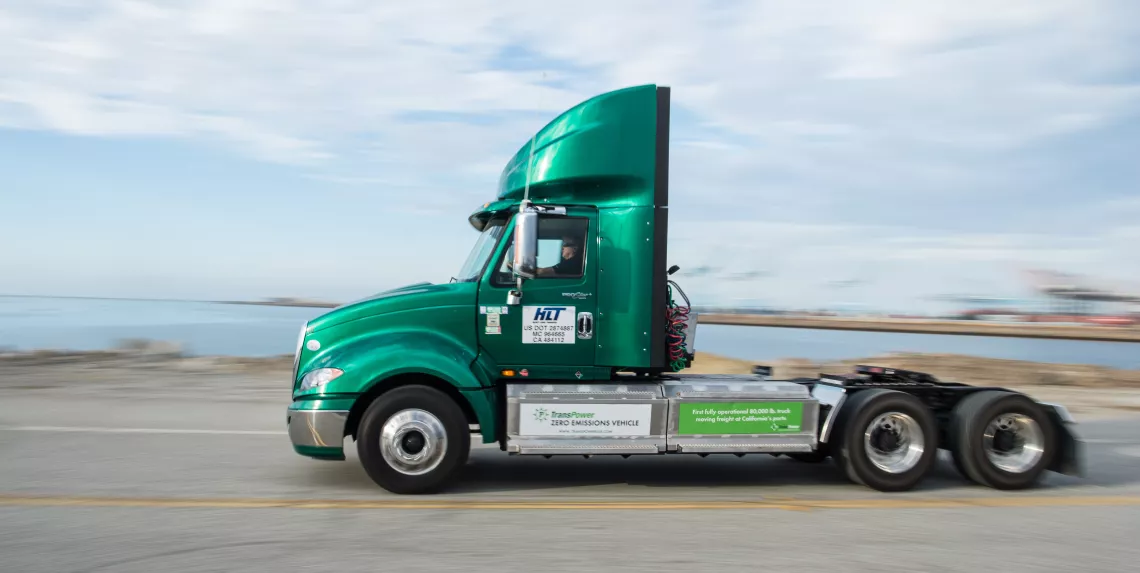Advocacy Organizations to EPA: We Need Strong Clean Truck Standards!

Photo by Dennis Schroeder, National Renewable Energy Laboratory
June 23, 2023
RE: Proposed Rule: Greenhouse Gas Emissions Standards for Heavy-Duty Vehicles – Phase 3
Dear Administrator Regan,
On behalf of the 32 undersigned advocacy groups, we urge the U.S. Environmental Protection Agency to finalize the strongest and most protective Greenhouse Gas (GHG) Emissions Standards possible for Heavy-Duty Vehicles before the end of 2023.
We support EPA finalizing standards that deliver additional pollution reductions beyond the proposal. Protective standards should help ensure ZEV deployment levels consistent with the Advanced Clean Trucks (ACT) Rule and secure even deeper reductions for truck classes responsible for disproportionate levels of pollution like tractor trailers. Standards at this level are supported by investments in clean trucks through the Inflation Reduction Act (IRA) and the Bipartisan Infrastructure Law (BIL), and expected growth in zero-emission truck and bus deployment from the ACT Rule in states that have adopted it.
The standard should accelerate the transition to a zero-emissions future through standards that put us on a path to reach 100 percent zero emissions from new trucks and buses no later than 2035, as frontline communities have been calling for. This is essential to protecting people’s health, especially in vulnerable communities; addressing the climate crisis; and supporting the market transition to zero-emission vehicles.
In the United States, transportation is the largest source of greenhouse gas emissions and air pollution exacerbating the climate crisis and severely impacting the public health of communities across the nation. According to the EPA’s own analysis, the transportation sector accounts for 27% of greenhouse gas emissions—more than any other sector in the US—and is the fastest-growing emitter of GHG emissions. While heavy-duty vehicles make up only 10% of vehicles on the road, they are responsible for 28% of GHG emissions, 45% of NOx emissions, and 57% of particulate matter emissions.
The American Lung Association estimates in counties with busy truck routes, the cumulative public health benefits by 2050 from the transition to zero-emission trucks would reach $735 billion. These benefits include 66,800 fewer premature deaths, 1.75 million fewer asthma attacks, and 8.5 million fewer lost workdays. It is essential that the EPA finalize the strongest and most protective HDV rule possible. We strongly encourage the EPA to issue robust and ambitious standards that account for technological advances in and cost savings from zero-emission technologies, including cost savings that will flow from investments and incentives provided by the IRA and BIL. In addition, EPA must finalize the HDV rule as soon as possible, as strong standards are pivotal to the United States meeting its GHG emission reduction targets over the coming decade and to providing long-overdue protections for impacted communities across the country.
The market is already transitioning to a zero-emission heavy-duty vehicle future. Major heavy-duty manufacturers, including Daimler, Ford, Navistar, and Volvo, have committed to increasing their share of zero-emission vehicle sales, eventually achieving 100% of all new vehicles sold. Additionally, major companies including DHL Group, FedEx, Ingka Group, and Walmart have committed to electrifying their fleets, with zero-emission targets ranging from 50% to 100% by 2030. EPA’s rule must account for and build on that momentum, putting industry on a path to achieving 100 percent zero emissions from new heavy-duty vehicles by 2035.
Vehicles such as zero-emission school buses, transit buses, delivery trucks, and refuse trucks are primed for deployment today. School buses are an especially important example because millions of children each day are exposed to toxic diesel pollution on their way to school. Zero-emission school buses provide public health and community resilience benefits, maintenance and operation savings, and even improve academic performance. Tighter emissions limits on school buses and all other on-road heavy-duty vehicles are long overdue.
Locomotives emit significant amounts of toxic diesel pollution and contribute to poor air quality nationwide. EPA’s proposed rule would also amend outdated regulations that inappropriately limit state and local government efforts to address air pollution from locomotives. This proposed update is necessary to achieve consistency with the Clean Air Act and to provide clarity to state and local governments.
By fully capturing the momentum created by historic federal investments and leading state policies, EPA can ensure the Phase 3 standards meet the Clean Air Act’s statutory command to protect public health and welfare. These standards will also position the United States as a leader in zero-emission vehicle technology development and manufacturing, provide high-quality job creation, and reduce burdens on frontline communities. We thank you for your consideration as you finalize the rule this year.
Sincerely,
Alliance of Nurses for Healthy Environments
The Asthma and Allergy Foundation of America (AAFA)
California Business Alliance for a Clean Economy
CALSTART
Chesapeake Bay Foundation
Clean Energy for America
Clean Energy Works
Coalition for Clean Air
Coltura
Dream.org
Ecology Center
Elders Climate Action
Electric School Bus Newsletter
Environmental Defense Fund
Environmental Law & Policy Center
Evergreen Action
EVHybridNoire
GreenLatinos
Illinois Environmental Council
Interfaith Power & Light
League of American Bicyclists
League of Conservation Voters (LCV)
MI Air MI Health
Michigan Environmental Council
Moms Clean Air Force
Plug In America
Project Green Home
Public Citizen
Save the Sound
Sierra Club
Southern Environmental Law Center
Southwest Energy Efficiency Project